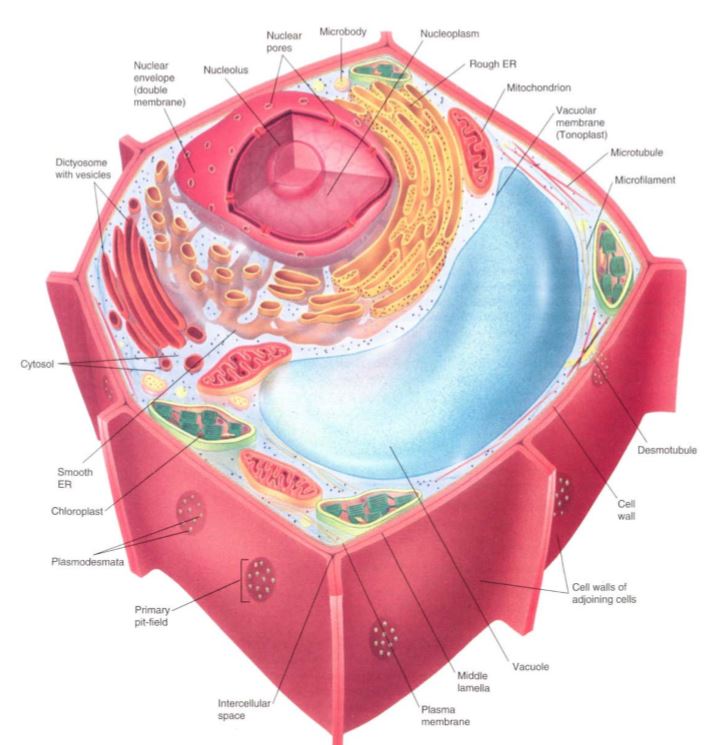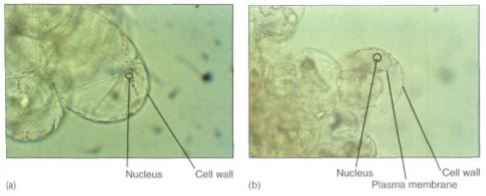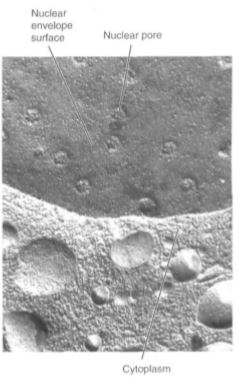


 النبات
النبات
 الحيوان
الحيوان
 الأحياء المجهرية
الأحياء المجهرية
 علم الأمراض
علم الأمراض
 التقانة الإحيائية
التقانة الإحيائية
 التقنية الحيوية المكروبية
التقنية الحيوية المكروبية
 التقنية الحياتية النانوية
التقنية الحياتية النانوية
 علم الأجنة
علم الأجنة
 الأحياء الجزيئي
الأحياء الجزيئي
 علم وظائف الأعضاء
علم وظائف الأعضاء
 الغدد
الغدد
 المضادات الحيوية
المضادات الحيوية|
Read More
Date: 31-10-2016
Date: 8-11-2016
Date: 16-10-2016
|
Basic Cell Types
At the most basic level, both cells and organisms can be classified as either prokaryotic or eukaryotic. Prokaryotic cells are simpler than eukaryotic ones and are found only in kingdom Monera: bacteria, cyanobacteria, and archaebacteria. It is hypothesized that they represent the most archaic lines of evolution and that eukaryotic cells evolved from them. Eukaryotic cells, found in plants, animals, fungi, and protists, are more complex than prokaryotic cells. The most striking difference, the one that gives them their name, is the presence of a true membrane-bounded nucleus in eukaryotic cells. In addition, there are many organelles that allow eukaryotic cells to be more diverse and complex, both morphologically and physiologically.
PLANT CELLS
Although various parts of a plant—roots, wood, bark, leaves, and flower parts—appear to be quite diverse, virtually all their cells have all the following organelles; the exceptions are rare. As each type of cell develops, certain organelles may become modified and more or less abundant, but usually none is lost completely (Fig. 1).
PROTOPLASM
All cells, either prokaryotic or eukaryotic, are made of a substance called protoplasm ( the protoplasm of a single cell is called its protoplast). This name was given early, when it was thought that protoplasm was a distinct substance like water, oxygen, or iron, and that one of its properties was life itself. We now know that protoplasm is a mass of proteins, lipids, nucleic acids, and water within a cell; except for the wall, everything in the cell is protoplasm, composed of the following organelles.
PLASMA MEMBRANE
The plasma membrane (less frequently called the plasmalemma) is the membrane that completely covers the surface of the protoplasm (Fig. 2). Because it is the outermost surface of the protoplast, it is selectively advantageous for it to be impermeable to harmful materials and permeable to beneficial ones; therefore, it is selectively permeable. There are molecular pumps in the plasma membrane that actively transport needed molecules inward and pump others outward for secretion. Because one side of the plasma membrane faces the external environment and the other side faces the cell, the two sides are quite different, especially in the types of protein they contain. We know very little about the proteins and lipids that make up the plasma membrane because the membrane does not separate cleanly from the protoplast. Almost all attempts to isolate the plasma membrane fir study have experienced considerable contamination from other parts of the cell.

FIGURE 1 : Generalized plant cell.

FIGURE 2 : (a) A healthy, growing cell. Its protoplast is pressed firmly against the cell wall, so its plasma membrane is not visible (X 160). (b) These cells have been treated with salt to draw water out of the cell, causing the protoplast to shrink. As a result, the plasma membrane is visible (X 160).
NUCLEUS
The nucleus (pl.: nuclei; see Fig. 1) serves as an archive, or permanent storage place, for the organism's genetic information. The book you are reading is just a brief introduction to plant biology. No one can imagine the number of pages required to store all the information necessary for building and maintaining a single cell. But all that information must be stored in the DNA inside every nucleus, and the storage must be safe and permanent. Information is useless unless it, or copies of it, can be retrieved and used. The nucleus carries out information retrieval by making copies of specific parts of the DNA whenever that information is needed. The copy is not DNA, but a type of ribonucleic acid called messenger RNA. An exciting area of research involves understanding how the nucleus, in response to signals from the rest of the cell, searches its DNA for the needed information and then makes copies of it without accidentally copying other similar information.
The nucleus of a eukaryotic cell is always surrounded by a nuclear envelope, which is actually an outer membrane and an inner membrane. The nuclear envelope separates the nuclear material from the rest of the cell, and it contains numerous small holes, nuclear pores (Fig. 3), that are involved in the transport of material between the nucleus and the rest of the protoplasm. Nuclear pores have a complex structure and exert control over the movement of materials. If a nucleus is extracted from a cell and placed into water, it swells; this can happen only if the pores prevent material from oozing out as the nucleus absorbs water. Prokaryotes have no nuclear envelope; instead DNA is simply mixed with the rest of the cell contents.
Within the nucleus is a substance called nucleoplasm. Like "protoplasm," this name was given before the composition was understood; we now know that nucleoplasm is a complex association of (1) DNA; (2) enzymes and other factors necessary to maintain, repair, and read DNA; (3) histone proteins that support and interact with DNA; (4) several types of RNA; and (5) water and numerous other substances necessary for nuclear metabolism. Nuclear DNA is always closely associated with histones, and this complex of the two is known as chromatin. As a cell ages or its metabolic activities change, so do the nucleus and nucleoplasm. In cells that are undergoing rapid cell division (for example, the cells in root tips, shoot tips, young leaves, and flower buds), the DNA, histones, and duplicating enzymes may dominate the nucleoplasm. But in mature cells that are not dividing, messenger molecules and reading enzymes may be more abundant.

FIGURE 3 : A preparation called a freeze-fracture: The cell is frozen and then tapped to cause it to break. The lipids of the membranes are weak when frozen, so the fracturing often follows the membranes, separating one lipid layer from the other. Here the fracture passed irregularly through the cytoplasm and then entered the nuclear envelope. The nuclear envelope consists of the outer and inner membranes, with a space separating them; the two membranes fuse together at the nuclear pores. Nuclear pores may be distributed uniformly over the nuclear surface or may occur in bands or patches in some species (X 60,000).
Inside every nucleus is one, two, or rarely several bodies called nucleoli (sing.: nucleolus; Fig. 4), areas where the components of ribosomes are synthesized and partially assembled. Each ribosome contains a large amount of ribosomal RNA copied from ribo- somal genes in the chromatin.
Nuclei are large, complex organelles, and frequently they occupy a major fraction of the cell volume (up to 50%; Table 3.5). In certain conducting cells (sieve tube members in phloem; see Chapter 5), the nucleus breaks down during cell differentiation, and the mature cell functions for several weeks or months without a nucleus. Our red blood cells are also enucleate (without a nucleus) at maturity. Both of these cell types are exceptional; they are enucleate only while performing a very limited type of metabolism, and they die shortly after losing the nucleus. Several types of plant cells are multinucleate.

FIGURE 4: Nucleoli usually stain more intensely than the rest of the nucleus; occasionally they stain a distinct color. Root tip of hyacinth (X 250).
Table : The Relative Volumes of Organelles in Plant Cell




|
|
|
|
دخلت غرفة فنسيت ماذا تريد من داخلها.. خبير يفسر الحالة
|
|
|
|
|
|
|
ثورة طبية.. ابتكار أصغر جهاز لتنظيم ضربات القلب في العالم
|
|
|
|
|
|
|
قسم شؤون المعارف ووفد من جامعة البصرة يبحثان سبل تعزيز التعاون المشترك
|
|
|